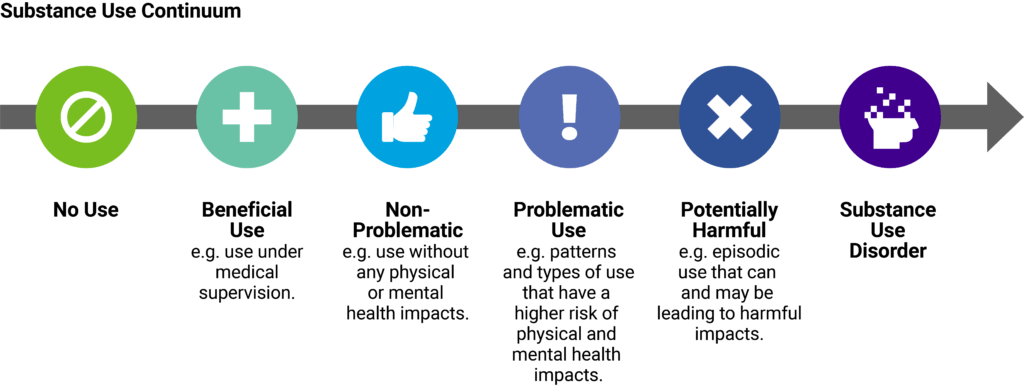Substance use prevention
Substance use is a complex issue that can have both immediate and long-term effects on students’ physical and psychological health. It’s important to understand the impact of substance use on students and to take a proactive approach to prevention and intervention.
Why this is important
- Schools can be both risk and protective factors for student substance use (Griffin & Botvin, 2010). For instance, peer influences and the pressures of school can be sources of stress that increase risk of substance use for students (Griffin & Botvin, 2010). On the other hand, providing effective prevention programming and extra-curricular activities can lower the risk of substance use (Public Health Agency of Canada, 2019).
- The school environment has been identified as an ideal location for prevention and support related to substance use (Evans-Whipp et al., 2004; Public Health Agency of Canada, 2019). The work you do at tier 1 to foster a mentally healthy school is prevention for substance use issues.
- As with the work to promote mental health in general, partnerships and relationships with parents/caregivers and community are critical to the prevention of substance use (Griffin & Botvin, 2010).
Substance use as a spectrum
Substance use occurs along a spectrum (commonly called a continuum of use) ranging from no use at all to experiencing a substance use disorder. A comprehensive approach requires evidence-based strategies that address the needs of all students, regardless of where they fall on the continuum of use. Problematic substance use and mental health problems often co-occur, regardless of which one comes first (School-Based Mental Health and Substance Abuse Consortium, 2013).

Substance use continuum – Adapted from First Nations Health Authority, British Columbia Ministry of Health & Health Canada (2013). A Path Forward: BC First Nations and Aboriginal People’s Mental Wellness and Substance Use – 10 Year Plan.
Research about substance use among children and youth
Globally, substance use among children and youth is an ongoing concern.
- The Ontario Student Drug Use and Health Survey (OSDUHS, 2021) found that among grade 7 to 12 students, the drugs most used were high-caffeine energy drinks, alcohol, and cannabis. More specifically, 14% of secondary students in the past year reported the use of cannabis to cope with a mental health problem (Boak et al., 2022).
- Furthermore, data from the Canadian Cannabis Survey (Health Canada, 2019) found that 44% of youth aged 16 to 19 reported cannabis use in the last year, up from 36% in 2018.
- Also noteworthy is that the impact of vaping on children and youth has received increased attention. While the OSDUHS found a slight decline of 8% in vaping from 2019 (23%) to 2021 (15%) (Boak et al., 2022), it remains a significant public health issue.
- For example, cannabis vaping is one type of substance use that has been documented among Canadian children and youth (Chadi et al., 2020). A study in Ontario and Quebec found that vaping increased among “youth aged 15 and older in Quebec between 2017 and 2019 and in Ontario between 2017 and 2018 and [that this was] driven by youth” (Czoli et al., 2015). See full article from Czoli et al. (2015) for statistics. Using data from the OSDUHS (2011 and 2013).
How schools can help
The school environment is an optimal place for prevention of substance use and to provide a tiered approach to addressing the needs of students.
- Prevention efforts in schools can include education about the risks and consequences of substance use, promotion of healthy coping strategies, and fostering a safe and supportive school climate (School-Based Mental Health and Substance Abuse Consortium, 2013).
- Schools can serve as important sources of information and support for students who may be at risk of substance use or who are already using substances (School-Based Mental Health and Substance Abuse Consortium, 2013). School administrators, along with other school staff, can identify early-warning signs of substance use and connect students with supports and services.
- Interventions may involve referral to substance-abuse supports, programs, and accommodations for academic and other needs (United Nations Educational, Scientific and Cultural Organization & World Health Organization, 2017).
- Schools can also collaborate with community organizations and healthcare providers to ensure that students have access to comprehensive and culturally responsive substance-abuse supports and services (Public Health Agency of Canada, 2019).
Resources about substance use
Chadi, N., Minato, C., & Stanwick, R. (2020). Cannabis vaping: Understanding the health risks of a rapidly emerging trend. Paediatrics & Child Health, 25(Supplement_1), S16–S20.
Czoli, C. D., Luongo, G., & Mischki, T. (2015). Prevalence trends and factors associated with vaping in Ontario (2015 to 2018) and Quebec (2017 to 2019), Canada. Health Reports, 33(82).
Evans-Whipp, T., Beyers, J. M., Lloyd, S., Lafazia, A. N., Toumbourou, J. W., Arthur, M. W., & Catalano, R. F. (2004). A review of school drug policies and their impact on youth substance use. Health promotion international, 19(2), 227–234.
Griffin, K. W., & Botvin, G. J. (2010). Evidence-based interventions for preventing substance use disorders in adolescents. Child and Adolescent Psychiatric Clinics of North America, 19(3), 505–526.
Health Canada. (2019). Canadian Cannabis Survey 2019: Summary.
Public Health Agency of Canada. (2019). Effective programming: Preventing problematic substance use through positive youth development. https://www.canada.ca/en/public-health/services/beyond-health-education-preventing-substance-use-enhancing-students-well-being/effective-programming.html
School-Based Mental Health and Substance Abuse Consortium. (2013). School-based mental health in Canada: A final report. Mental Health Commission of Canada.
United Nations Educational, Scientific and Cultural Organization (UNESCO) & World Health Organization. (2017). Good policy and practice in health education: Education sector responses to the use of alcohol, tobacco and drugs. UNESCO.
